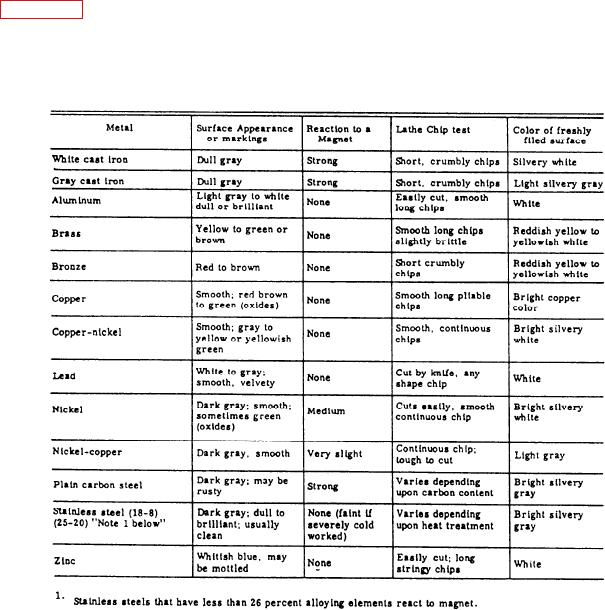
and file test. When you perform these tests, you
IDENTIFICATION OF METALS
should compare the unknown metal with a known
sample of some metal. You also will need good
The various base metals, such as iron, copper,
lighting, a strong permanent magnet, and access to a
lead, zinc, and aluminum have certain identifying
lathe. A word of caution: when you perform these
characteristics, such as surface appearance and
tests, DO NOT be satisfied with the results of only
weight. This helps persons who work with or handle
one test. Use as many tests as possible so you can
these materials to distinguish one from another.
increase the chances of an accurate identification.
There are, however, a number of related alloys that
resemble each other and their base metal so closely
that they defy accurate identification by simple
Spark Test
means. You may have to send these metals to a
shipyard for analysis.
There are other means of rapid identification of
Spark testing is the identification of a metal by
observing the color, size, and shape of the spark
metals. These methods, however, do not provide
stream given off when you hold the metal against a
positive identification and should not be used in
grinding wheel. This method of identification is
critical situations where a specific metal is required.
adequate for most machine shop purposes. When you
Some of the methods that we'll discuss here are
must know the exact composition of a metal, make a
magnet tests, chip tests, file tests, acid reaction tests,
and spark tests. The latter two are most commonly
chemical analysis. You need a lot of experience
used by the Navy and we'll discuss them in more
before you can identifiy metals by a spark test. To
detail. Table 3-3 contains information related to
gain this experience, you'll need to practice by
surface appearance, magnetic reaction, lathe chip test,
comparing the spark stream of unknown specimens
Table 3-3.--Rapid Identification of Metals
3-11

